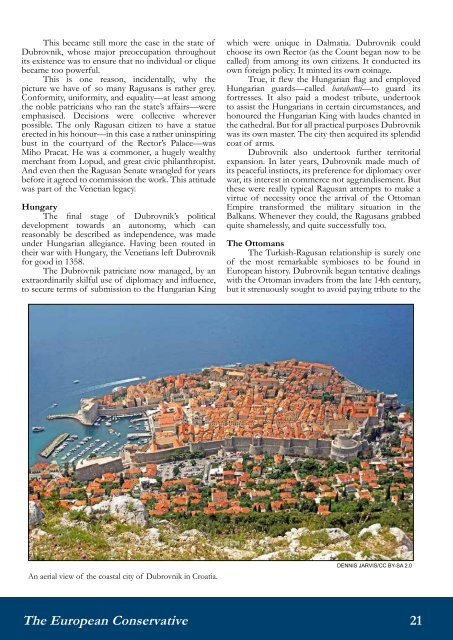CONSERVATIVE
eurocon_12_2015_summer-fall
eurocon_12_2015_summer-fall
- No tags were found...
Create successful ePaper yourself
Turn your PDF publications into a flip-book with our unique Google optimized e-Paper software.
This became still more the case in the state of<br />
Dubrovnik, whose major preoccupation throughout<br />
its existence was to ensure that no individual or clique<br />
became too powerful.<br />
This is one reason, incidentally, why the<br />
picture we have of so many Ragusans is rather grey.<br />
Conformity, uniformity, and equality—at least among<br />
the noble patricians who ran the state’s affairs—were<br />
emphasised. Decisions were collective wherever<br />
possible. The only Ragusan citizen to have a statue<br />
erected in his honour—in this case a rather uninspiring<br />
bust in the courtyard of the Rector’s Palace—was<br />
Miho Pracat. He was a commoner, a hugely wealthy<br />
merchant from Lopud, and great civic philanthropist.<br />
And even then the Ragusan Senate wrangled for years<br />
before it agreed to commission the work. This attitude<br />
was part of the Venetian legacy.<br />
Hungary<br />
The final stage of Dubrovnik’s political<br />
development towards an autonomy, which can<br />
reasonably be described as independence, was made<br />
under Hungarian allegiance. Having been routed in<br />
their war with Hungary, the Venetians left Dubrovnik<br />
for good in 1358.<br />
The Dubrovnik patriciate now managed, by an<br />
extraordinarily skilful use of diplomacy and influence,<br />
to secure terms of submission to the Hungarian King<br />
which were unique in Dalmatia. Dubrovnik could<br />
choose its own Rector (as the Count began now to be<br />
called) from among its own citizens. It conducted its<br />
own foreign policy. It minted its own coinage.<br />
True, it flew the Hungarian flag and employed<br />
Hungarian guards—called barabanti—to guard its<br />
fortresses. It also paid a modest tribute, undertook<br />
to assist the Hungarians in certain circumstances, and<br />
honoured the Hungarian King with laudes chanted in<br />
the cathedral. But for all practical purposes Dubrovnik<br />
was its own master. The city then acquired its splendid<br />
coat of arms.<br />
Dubrovnik also undertook further territorial<br />
expansion. In later years, Dubrovnik made much of<br />
its peaceful instincts, its preference for diplomacy over<br />
war, its interest in commerce not aggrandisement. But<br />
these were really typical Ragusan attempts to make a<br />
virtue of necessity once the arrival of the Ottoman<br />
Empire transformed the military situation in the<br />
Balkans. Whenever they could, the Ragusans grabbed<br />
quite shamelessly, and quite successfully too.<br />
The Ottomans<br />
The Turkish-Ragusan relationship is surely one<br />
of the most remarkable symbioses to be found in<br />
European history. Dubrovnik began tentative dealings<br />
with the Ottoman invaders from the late 14th century,<br />
but it strenuously sought to avoid paying tribute to the<br />
An aerial view of the coastal city of Dubrovnik in Croatia.<br />
DENNIS JARVIS/CC BY-SA 2.0<br />
The European Conservative 21


